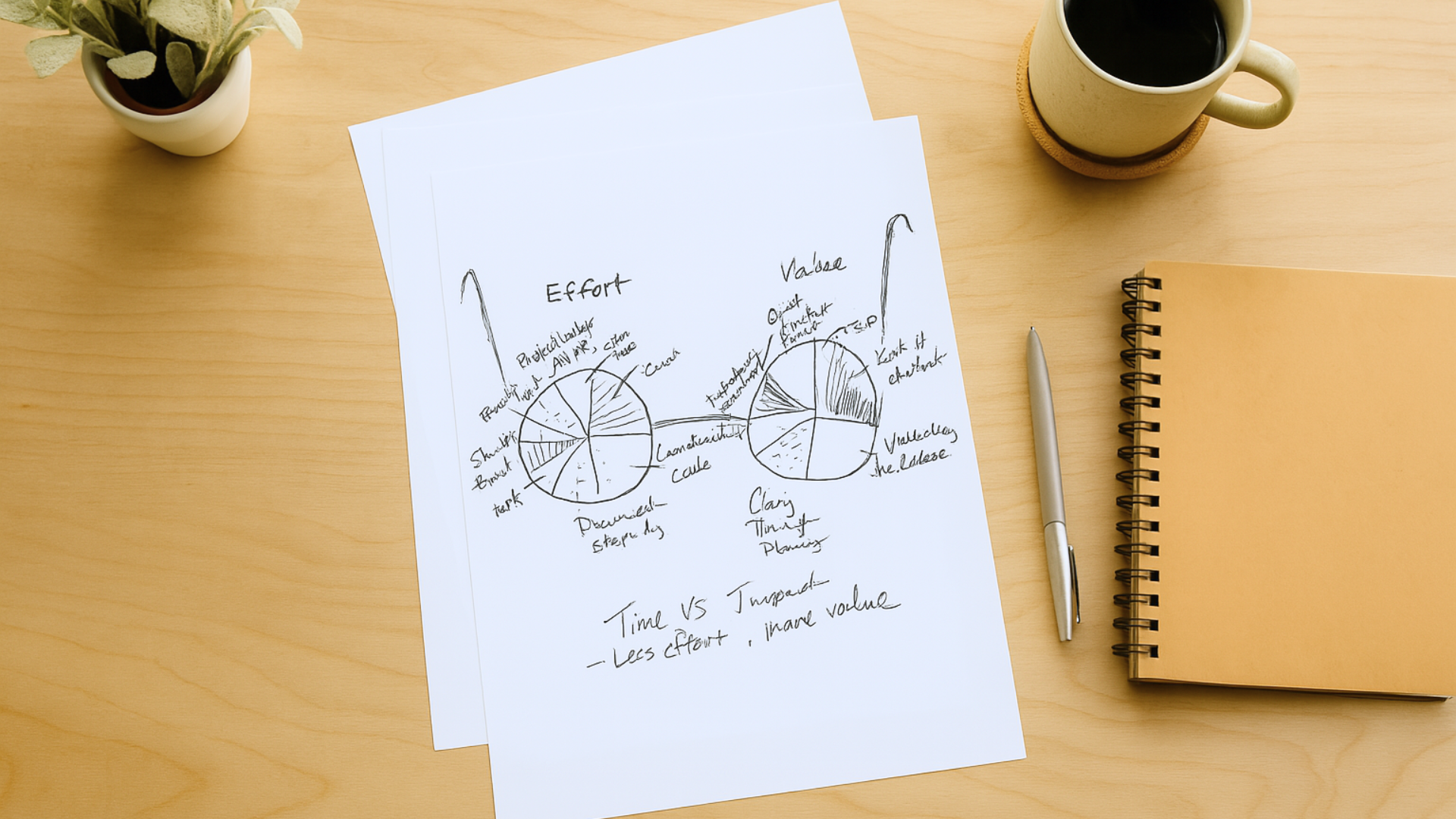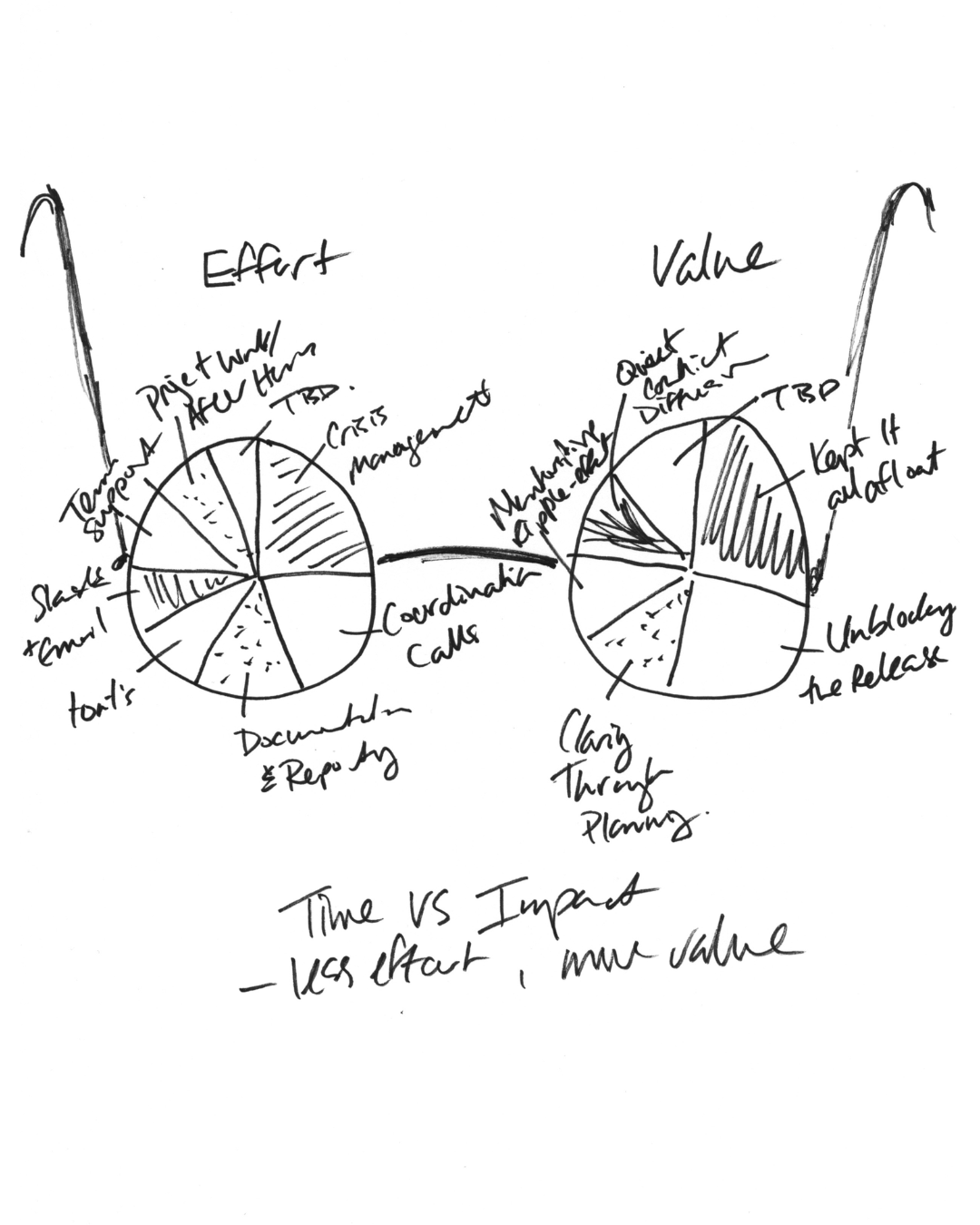How High-Achieving Women Can Track Effort vs Value

What Are You Really Getting Back from All That Effort?
Carris is one of those women who seems like she’s holding everything together — because she is. As a technical program manager in a large software company, she’s dependable, efficient, and constantly in motion. Her calendar is stacked with meetings. Her inbox pings into the evening. Her team relies on her to unblock bottlenecks, smooth communication, and quietly keep projects on track.
But when she came to our session, Carris admitted something that might sound familiar.
“I end every week exhausted,” she said. “But I don’t know what I’ve actually accomplished.”
Carris isn’t alone in this. Many high-achieving women in STEM end up in a cycle of invisible labour and misaligned effort — doing the work that keeps things moving, but rarely having space to reflect on what’s truly creating value.
That’s why I introduced her to a coaching tool called the Value–Effort Glasses.
Seeing Through a Different Lens
The tool itself is deceptively simple: two circles, drawn side by side.
- The left circle represents how your energy is spent — the meetings, the tasks, the responsibilities that fill your week.
- The right circle represents the value you’ve created — not just what got checked off a list, but what truly made a difference.
We began by defining a time frame — in Carris’s case, a typical workweek. Then we sketched the first circle and started mapping out her regular activities. She divided her weekly effort into slices:
- Crisis Management – 25%
- Coordination Calls – 20%
- Documentation & Reporting – 15%
- Project Work (After Hours) – 10%
- One-on-Ones – 9%
- Slack & Email – 8%
- Team Support – 5%
These were the things eating up her time and energy. Some were visible and expected. Others — like late-night project work and informal team mentoring — were hidden under the surface.
When we moved to the second circle, the tone shifted.
This time, Carris identified where value was actually being created:
- Unblocking the Release – 25%
- Kept It All Afloat – 30%
- Clarity Through Planning – 20%
- Mentorship Ripple Effect – 10%
- Quiet Conflict Diffusion – 10%
What stood out immediately was how disconnected
the two lenses were. The activities that drained her — like back-to-back meetings and constant firefighting — were not the same ones creating value.
The Aha Moment
After the two circles were drawn, we connected them with a simple line to form a pair of “glasses.” Carris leaned in and studied the image for a long time.
Then she said something that stopped us both.
“Some of the things I barely spend time on are creating the biggest impact… and the things that drain me the most don’t even show up here.”
It was a moment of clarity that didn’t come from a spreadsheet or a to-do list — but from seeing the imbalance in her own hand-drawn visual.

Why Visual Coaching Works
Tools like the Value–Effort Glasses can be especially powerful for women like Carris — analytical thinkers, planners, perfectionists, and quiet leaders. When your mind is full of details, deadlines, and deliverables, it’s easy to lose the thread of meaning.
Drawing a visual map slows the brain just enough to notice patterns.
It does a few important things:
- Interrupts autopilot thinking: By stepping out of verbal problem-solving mode, you invite reflection instead of just analysis.
- Reveals emotional insight: Seeing energy spent versus value created side by side often evokes strong feelings — frustration, relief, grief, or validation.
- Invites decision-making: Once the imbalance is seen, the client often starts to name what needs to shift — gently, clearly, and with self-compassion.
In Carris’s case, she realized that her true contributions — mentoring, unblocking progress, quietly stabilizing her team — were deeply meaningful. But they weren’t getting space in her calendar, or recognition in her metrics.
This insight helped her shift how she saw her role — not by working harder, but by working with more intention.
How Carris Began to Reclaim Her Time
We ended the session by imagining what her “glasses” might look like six months from now.
She didn’t talk about big changes. She didn’t mention promotions or productivity hacks.
Instead, she said:
“I’d like to protect just one afternoon a week for real project work. I’d like to make mentoring more visible. And I want to feel proud of how I spend my energy — not just drained by it.”
That’s the beauty of visual coaching tools. They don’t demand grand reinvention. They invite small, aligned changes — the kind that actually stick.
Try It Yourself
If Carris’s story resonates with you, you can try a version of the Value–Effort Glasses on your own.
All you need is a blank sheet of paper and a quiet moment.
- Draw two circles side by side.
- Label the first one “Effort” and divide it into slices representing how you spend your time in a typical week.
- Label the second one “Value” and divide it into slices showing where your work truly makes a difference — for others, and for you.
- Connect the circles with a simple line. Now you have your glasses.
What do they show you?
What’s missing?
What would you like to shift?
Final Thoughts
Carris didn’t need to do more. She needed to see differently.
In a world that constantly pushes for productivity, sometimes the real breakthrough is remembering what matters — and where your value already lives.
If you’re curious about coaching tools like this one, or looking for simple ways to reconnect with your energy and clarity, I invite you to subscribe to The Creative Shift, my weekly newsletter, or explore the 5-Day Creative Reset Challenge.
Your energy is precious. Let’s make sure it’s going where it counts.